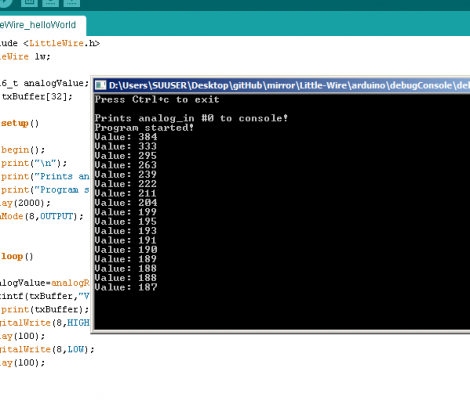Arduino Serial Printf
Arduino – Printing Float values to the Serial Port 2013/01/20 10:34 am / 1 Comment / Bertus Kruger I found that printing floating is a bit harder than it needs to be. Use Serial.print to Display Arduino output on your computer monitor: Part 1 In many cases while using an Arduino, you will want to see the data being generated by the Arduino. One common method of doing this is using the Serial.print function from the Serial library to display information to your computer’s monitor. Serial.print('N') gives 'N' Serial.print('Hello world.' ) gives 'Hello world.' An optional second parameter specifies the base (format) to use; permitted values are BIN(binary, or base 2), OCT(octal, or base 8), DEC(decimal, or base 10), HEX(hexadecimal, or base 16). First of all, since you are coding for an Arduino and the data that will be processed by a scanf is coming thru a Serial port, then first code a routine to read a serial port for the data that you need. You will find that this is NOT a simple task, and that you will end up with routines to read ASCII characters of integers, letters, etc. A Better Serial.print For Arduino Posted on August 8, 2011 by David Pankhurst In a previous article I described how to add the old-fashioned print function to Arduino to improve debugging – after all, it gets tedious to use a separate Serial.print function for each type – and inserting information into a string is printf’s specialty. Aug 16, 2013 First of all, since you are coding for an Arduino and the data that will be processed by a scanf is coming thru a Serial port, then first code a routine to read a serial port for the data that you need. You will find that this is NOT a simple task, and that you will end up with routines to read ASCII characters of integers, letters, etc.
- Arduino Serial.printf Float
- Arduino Print To Serial Monitor
- Arduino Serial Printf Format
- Arduino Serial Print Printf
Based on this approach I wanted to implement a function for formatted printing data to the serial monitor. I tried the code below:
But it gives me some weird output: Mersive solstice download for mac.
Arduino Serial.printf Float
What do 2263 and 2269 mean? Why does it happen only inside the function? What is my mistake and how can I fix it?
1 Answer
The problem with your code is that you are mixing the 'normal' and 'variadic' forms of the printf functions.
Any printf function starting with V takes a variadic argument list pointer as its last variable. Any printf function which doesn't start with V takes a variadic list of individual variables.
When calculating your buffer size from a list of variables in your main loop you are incorrectly using vsnprintf - you should be using snprintf since you aren't passing it a va_list, but individual variables. In your _printf function you are correctly using vsnprintf to calculate the length of the buffer, but then incorrectly using sprintf with a va_list instead of individual variables.
So your two forms should actually be re-written as:

and:
Remember: if you have a va_list then it goes with a v*printf function. If you have individual variables they go with a *printf function.
Arduino Print To Serial Monitor
MajenkoArduino Serial Printf Format
♦MajenkoArduino Serial Print Printf
